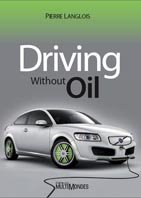
ILLUSTRATION - Comparison between the chain of energy processing and distribution for vehicles with hydrogen-FC, right, and the chain for battery electric vehicles to the left. FC-hydrogen vehicles use 3 times more electricity than battery electric vehicles or plug-in hybrid vehicles in electric mode. (Drawing from my latest book «Rouler sans pétrole»)
Hydrogen and fuel cells (FC) have been presented since the mid-1990s as a panacea to the problems of pollution caused by motor vehicles, as only water vapor comes out the exhaust pipe. Furthermore, knowing that 96% of hydrogen is currently produced from fossil fuels, oil and gas industries see the arrival of a hydrogen economy as a good thing for their businesses.
The main advantages of hydrogen put forward are the ability to tank in less than 10 minutes and offer a range of 500 km, unlike batteries, which took several hours to recharge and limited the range of an electric car at about 200 km. However, since 2007 the new lithium titanate batteries, such as those of Altairnano or Toshiba, can also be recharged in less than 10 minutes. In addition, with a plug-in hybrid car we can also fill up with gazoline in less than 10 minutes for a range of 700 km, while driving the vast majority of our mileage with electricity from the grid.
Let us not forget that hydrogen does not occur naturally on Earth. It is associated, among others, with oxygen to form water and carbon to form hydrocarbons (oil and natural gas) or coal. To obtain the hydrogen, we must first separate it from the molecules where it is found. This separation process consumes energy, and produces CO2 when using fossil fuels as a source of hydrogen.
Although some automobile manufacturers have built great FC-hydrogen cars without emissions when we drive them, hydrogen is not as good as they say. Several experts, including Ulf Bossel, demonstrated that the hydrogen economy was not really viable, and that we go away from sustainable development by taking this path. The main reasons are (details and demonstrations in my book «Rouler sans pétrole»):
* When the hydrogen is produced by reforming natural gas and electricity is produced with a natural gas power plant, a FC-hydrogen car emits 50% more CO2 than a battery electric car or a plug-in hybrid in electric mode.
* When the hydrogen is produced by electrolysis of water using renewables (no CO2) FC-hydrogen vehicles use three times more electricity than battery electric vehicles or plug-in hybrid vehicles in electric mode.
* We would have to invest hundreds of billions of dollars to set up a distribution infrastructure for hydrogen.
* Filling up with hydrogen would be at least five times more expensive than with electricity. It is about 15 times more expensive today.
* The explosive aspect of hydrogen brings security problems with its distribution on a large scale to the common people. In addition, to supply a service station, we need 15 trucks of compressed hydrogen to replace one gasoline truck, adding to the dangers on the roads.
* The development of FC-hydrogen vehicles is ten years late with respect to plug-in hybrids. Thus, FC-hydrogen vehicles offering no particular advantage, on the contrary, makes a penetration of the market very unlikely.
It is time to turn the page of the "hydrogen expenditure" to quickly develop a real "electron economy".





FC-hydrogen vehicles use 3 times more electricity than battery electric vehicles or plug-in hybrid vehicles in electric mode.used cars for sale las vegas nv
ReplyDelete